Botian Jiang
Decoupled Proxy Alignment: Mitigating Language Prior Conflict for Multimodal Alignment in MLLM
Sep 18, 2025Abstract:Multimodal large language models (MLLMs) have gained significant attention due to their impressive ability to integrate vision and language modalities. Recent advancements in MLLMs have primarily focused on improving performance through high-quality datasets, novel architectures, and optimized training strategies. However, in this paper, we identify a previously overlooked issue, language prior conflict, a mismatch between the inherent language priors of large language models (LLMs) and the language priors in training datasets. This conflict leads to suboptimal vision-language alignment, as MLLMs are prone to adapting to the language style of training samples. To address this issue, we propose a novel training method called Decoupled Proxy Alignment (DPA). DPA introduces two key innovations: (1) the use of a proxy LLM during pretraining to decouple the vision-language alignment process from language prior interference, and (2) dynamic loss adjustment based on visual relevance to strengthen optimization signals for visually relevant tokens. Extensive experiments demonstrate that DPA significantly mitigates the language prior conflict, achieving superior alignment performance across diverse datasets, model families, and scales. Our method not only improves the effectiveness of MLLM training but also shows exceptional generalization capabilities, making it a robust approach for vision-language alignment. Our code is available at https://github.com/fnlp-vision/DPA.
UnifiedVisual: A Framework for Constructing Unified Vision-Language Datasets
Sep 18, 2025Abstract:Unified vision large language models (VLLMs) have recently achieved impressive advancements in both multimodal understanding and generation, powering applications such as visual question answering and text-guided image synthesis. However, progress in unified VLLMs remains constrained by the lack of datasets that fully exploit the synergistic potential between these two core abilities. Existing datasets typically address understanding and generation in isolation, thereby limiting the performance of unified VLLMs. To bridge this critical gap, we introduce a novel dataset construction framework, UnifiedVisual, and present UnifiedVisual-240K, a high-quality dataset meticulously designed to facilitate mutual enhancement between multimodal understanding and generation. UnifiedVisual-240K seamlessly integrates diverse visual and textual inputs and outputs, enabling comprehensive cross-modal reasoning and precise text-to-image alignment. Our dataset encompasses a wide spectrum of tasks and data sources, ensuring rich diversity and addressing key shortcomings of prior resources. Extensive experiments demonstrate that models trained on UnifiedVisual-240K consistently achieve strong performance across a wide range of tasks. Notably, these models exhibit significant mutual reinforcement between multimodal understanding and generation, further validating the effectiveness of our framework and dataset. We believe UnifiedVisual represents a new growth point for advancing unified VLLMs and unlocking their full potential. Our code and datasets is available at https://github.com/fnlp-vision/UnifiedVisual.
Prior-Fitted Networks Scale to Larger Datasets When Treated as Weak Learners
Mar 03, 2025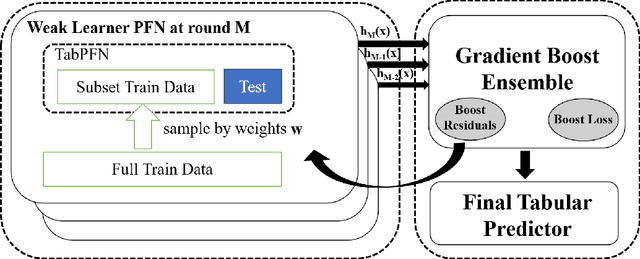



Abstract:Prior-Fitted Networks (PFNs) have recently been proposed to efficiently perform tabular classification tasks. Although they achieve good performance on small datasets, they encounter limitations with larger datasets. These limitations include significant memory consumption and increased computational complexity, primarily due to the impracticality of incorporating all training samples as inputs within these networks. To address these challenges, we investigate the fitting assumption for PFNs and input samples. Building on this understanding, we propose \textit{BoostPFN} designed to enhance the performance of these networks, especially for large-scale datasets. We also theoretically validate the convergence of BoostPFN and our empirical results demonstrate that the BoostPFN method can outperform standard PFNs with the same size of training samples in large datasets and achieve a significant acceleration in training times compared to other established baselines in the field, including widely-used Gradient Boosting Decision Trees (GBDTs), deep learning methods and AutoML systems. High performance is maintained for up to 50x of the pre-training size of PFNs, substantially extending the limit of training samples. Through this work, we address the challenges of efficiently handling large datasets via PFN-based models, paving the way for faster and more effective tabular data classification training and prediction process. Code is available at Github.
Advancing Fine-Grained Visual Understanding with Multi-Scale Alignment in Multi-Modal Models
Nov 14, 2024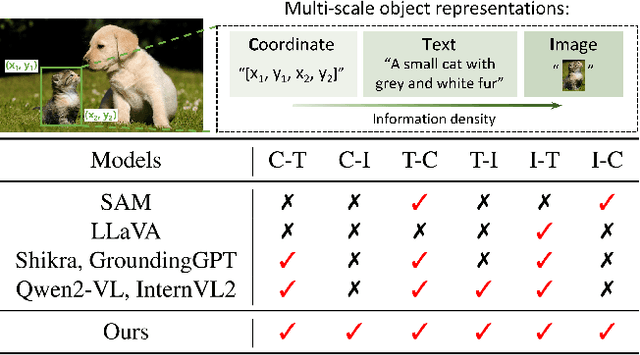
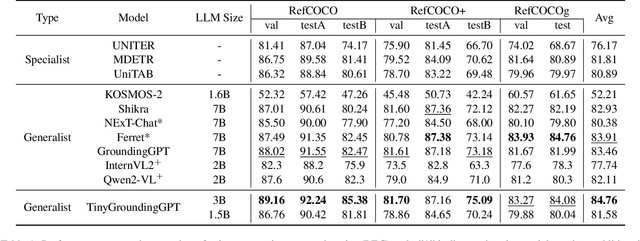
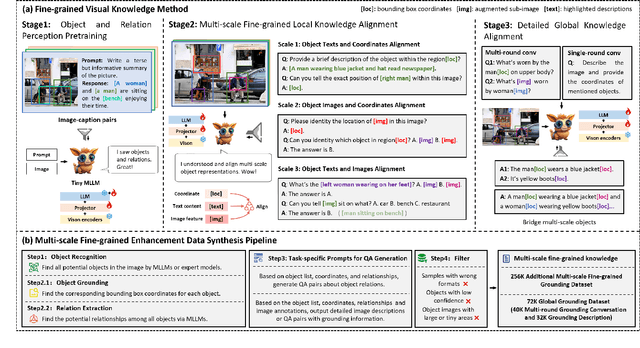
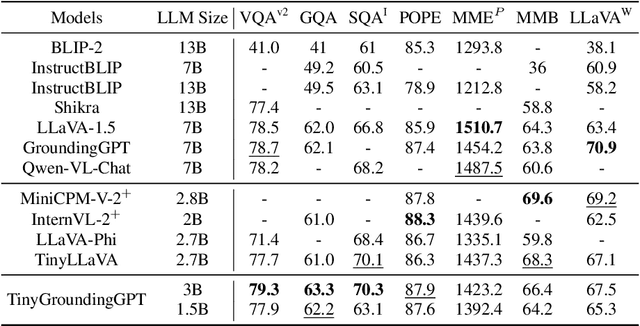
Abstract:Multi-modal large language models (MLLMs) have achieved remarkable success in fine-grained visual understanding across a range of tasks. However, they often encounter significant challenges due to inadequate alignment for fine-grained knowledge, which restricts their ability to accurately capture local details and attain a comprehensive global perception. While recent advancements have focused on aligning object expressions with grounding information, they typically lack explicit integration of object images, which contain affluent information beyond mere texts or coordinates. To bridge this gap, we introduce a novel fine-grained visual knowledge alignment method that effectively aligns and integrates multi-scale knowledge of objects, including texts, coordinates, and images. This innovative method is underpinned by our multi-scale fine-grained enhancement data synthesis pipeline, which provides over 300K essential training data to enhance alignment and improve overall performance. Furthermore, we present TinyGroundingGPT, a series of compact models optimized for high-level alignments. With a scale of approximately 3B parameters, TinyGroundingGPT achieves outstanding results in grounding tasks while delivering performance comparable to larger MLLMs in complex visual scenarios.
Understanding the Role of LLMs in Multimodal Evaluation Benchmarks
Oct 16, 2024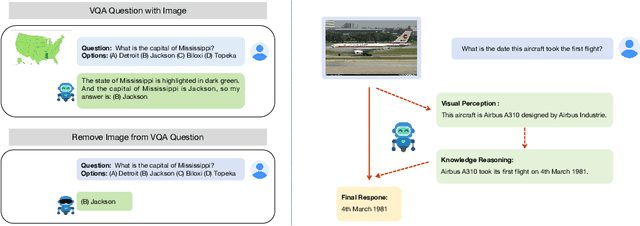
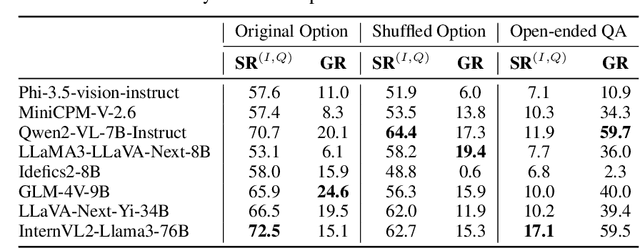
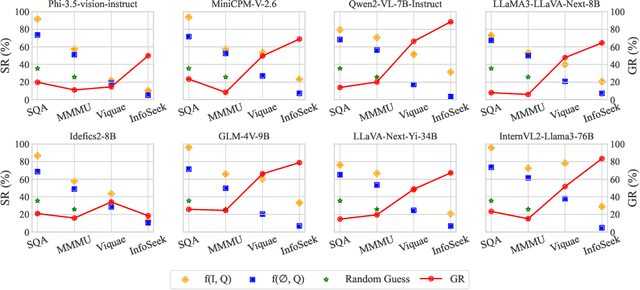

Abstract:The rapid advancement of Multimodal Large Language Models (MLLMs) has been accompanied by the development of various benchmarks to evaluate their capabilities. However, the true nature of these evaluations and the extent to which they assess multimodal reasoning versus merely leveraging the underlying Large Language Model (LLM) backbone remain unclear. This paper presents a comprehensive investigation into the role of LLM backbones in MLLM evaluation, focusing on two critical aspects: the degree to which current benchmarks truly assess multimodal reasoning and the influence of LLM prior knowledge on performance. Specifically, we introduce a modified evaluation protocol to disentangle the contributions of the LLM backbone from multimodal integration, and an automatic knowledge identification technique for diagnosing whether LLMs equip the necessary knowledge for corresponding multimodal questions. Our study encompasses four diverse MLLM benchmarks and eight state-of-the-art MLLMs. Key findings reveal that some benchmarks allow high performance even without visual inputs and up to 50\% of error rates can be attributed to insufficient world knowledge in the LLM backbone, indicating a heavy reliance on language capabilities. To address knowledge deficiencies, we propose a knowledge augmentation pipeline that achieves significant performance gains, with improvements of up to 60\% on certain datasets, resulting in a approximately 4x increase in performance. Our work provides crucial insights into the role of the LLM backbone in MLLMs, and highlights the need for more nuanced benchmarking approaches.
UnifiedMLLM: Enabling Unified Representation for Multi-modal Multi-tasks With Large Language Model
Aug 05, 2024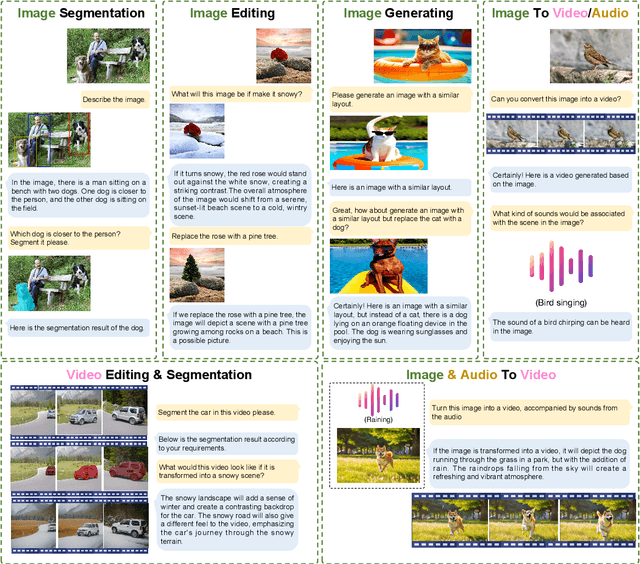

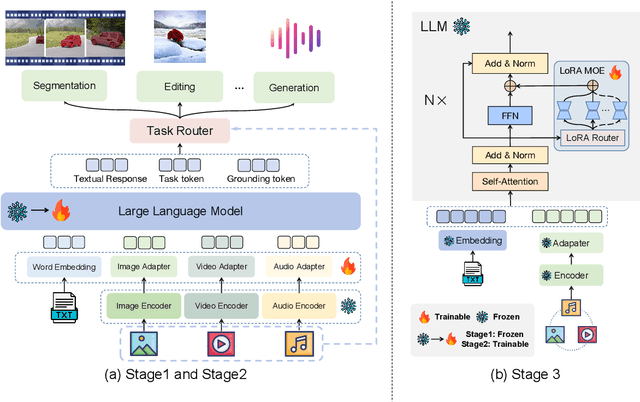

Abstract:Significant advancements has recently been achieved in the field of multi-modal large language models (MLLMs), demonstrating their remarkable capabilities in understanding and reasoning across diverse tasks. However, these models are often trained for specific tasks and rely on task-specific input-output formats, limiting their applicability to a broader range of tasks. This raises a fundamental question: Can we develop a unified approach to represent and handle different multi-modal tasks to maximize the generalizability of MLLMs? In this paper, we propose UnifiedMLLM, a comprehensive model designed to represent various tasks using a unified representation. Our model exhibits strong capabilities in comprehending the implicit intent of user instructions and preforming reasoning. In addition to generating textual responses, our model also outputs task tokens and grounding tokens, serving as indicators of task types and task granularity. These outputs are subsequently routed through the task router and directed to specific expert models for task completion. To train our model, we construct a task-specific dataset and an 100k multi-task dataset encompassing complex scenarios. Employing a three-stage training strategy, we equip our model with robust reasoning and task processing capabilities while preserving its generalization capacity and knowledge reservoir. Extensive experiments showcase the impressive performance of our unified representation approach across various tasks, surpassing existing methodologies. Furthermore, our approach exhibits exceptional scalability and generality. Our code, model, and dataset will be available at \url{https://github.com/lzw-lzw/UnifiedMLLM}.
InferAligner: Inference-Time Alignment for Harmlessness through Cross-Model Guidance
Jan 20, 2024



Abstract:With the rapid development of large language models (LLMs), they are not only used as general-purpose AI assistants but are also customized through further fine-tuning to meet the requirements of different applications. A pivotal factor in the success of current LLMs is the alignment process. Current alignment methods, such as supervised fine-tuning (SFT) and reinforcement learning from human feedback (RLHF), focus on training-time alignment and are often complex and cumbersome to implement. Therefore, we develop \textbf{InferAligner}, a novel inference-time alignment method that utilizes cross-model guidance for harmlessness alignment. InferAligner utilizes safety steering vectors extracted from safety-aligned model to modify the activations of the target model when responding to harmful inputs, thereby guiding the target model to provide harmless responses. Experimental results show that our method can be very effectively applied to domain-specific models in finance, medicine, and mathematics, as well as to multimodal large language models (MLLMs) such as LLaVA. It significantly diminishes the Attack Success Rate (ASR) of both harmful instructions and jailbreak attacks, while maintaining almost unchanged performance in downstream tasks.
Watermarking LLMs with Weight Quantization
Oct 17, 2023



Abstract:Abuse of large language models reveals high risks as large language models are being deployed at an astonishing speed. It is important to protect the model weights to avoid malicious usage that violates licenses of open-source large language models. This paper proposes a novel watermarking strategy that plants watermarks in the quantization process of large language models without pre-defined triggers during inference. The watermark works when the model is used in the fp32 mode and remains hidden when the model is quantized to int8, in this way, the users can only inference the model without further supervised fine-tuning of the model. We successfully plant the watermark into open-source large language model weights including GPT-Neo and LLaMA. We hope our proposed method can provide a potential direction for protecting model weights in the era of large language model applications.
SeqXGPT: Sentence-Level AI-Generated Text Detection
Oct 13, 2023Abstract:Widely applied large language models (LLMs) can generate human-like content, raising concerns about the abuse of LLMs. Therefore, it is important to build strong AI-generated text (AIGT) detectors. Current works only consider document-level AIGT detection, therefore, in this paper, we first introduce a sentence-level detection challenge by synthesizing a dataset that contains documents that are polished with LLMs, that is, the documents contain sentences written by humans and sentences modified by LLMs. Then we propose \textbf{Seq}uence \textbf{X} (Check) \textbf{GPT}, a novel method that utilizes log probability lists from white-box LLMs as features for sentence-level AIGT detection. These features are composed like \textit{waves} in speech processing and cannot be studied by LLMs. Therefore, we build SeqXGPT based on convolution and self-attention networks. We test it in both sentence and document-level detection challenges. Experimental results show that previous methods struggle in solving sentence-level AIGT detection, while our method not only significantly surpasses baseline methods in both sentence and document-level detection challenges but also exhibits strong generalization capabilities.
 Add to Chrome
Add to Chrome Add to Firefox
Add to Firefox Add to Edge
Add to Edge